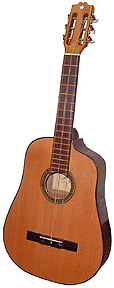Converting A Spanish Guitar To A Tres
What is a Tres?
A Tres is a 3 course instrument
similar to a guitar - it is one of the main instruments in Cuban music
- more info at "The
Tres in Cuba"

"The Tres is generally unknown among many otherwise knowledgeable
fans of fretted stringed instruments, yet it is a vital expressive tool that
has shaped the sound of Latin American music since the last century. Note:
Cuban tres players often call themselves treseros; while Puerto Ricans playing
the tres often call themselves tresistas"
A customer who is a regular six string guitar player went to Cuba for a holiday
and really enjoyed the local music scene and had some lessons with a cuban
tresero. On his return he wanted to carry on with the tres and came to me
with the idea of converting a cheap nylon string acoustic.
The Conversion
As the stringing arrangement of the tres requires six machine heads it
is a relatively simple process to change a classical or spanish guitar
from six single strings to three pairs of strings.
All that's required is to cut three extra slots in the nut and six slots
in the bridge saddle.
The Nut

As my customer had decided that he was going to use a capo at the second
fret the depth of the nut slots was not critical - I would recommend this
approach as it makes a DIY job much simpler.
If you don't want to use a capo or don't feel competent to cut the slots
you could get your local luthier to do this.
Using the existing 1st, 3rd and 5th string slots as the location for
the top strings of the pairs I cut the new slots about 3mm inside these
three slots (see pic)
I used needle files to cut the slots but something like a small hacksaw
could do the job.
The Bridge

The reason for using strings 1,3 and 5 rather than using
the whole width of the neck is that you can use the existing holes in
the bridge to hold two strings each - this is much simpler than having
to drill new holes but it does mean you have to cut six small notches
in the bridge saddle to keep the strings of each pair apart.
In Cuba the tres strings are normally metal and I'm sure
this conversion would work with steel strings - however my customer
wanted to use nylon strings as that's what he normally uses on guitar.
We used 2 top E strings and 2 B strings from nylon sets
for the top 2 pairs. These are tuned in unison.
For the 3rd pair we used a top E nylon string plus a wound
"silk and steel" 3rd string.
This pair is tuned an octave apart
with the highest note at the bottom.
The tres is tuned( from the top) EE CC GG¹
For steel strings I'd recommend these gauges - 12 12 ; 15 15 ; 24w
9
This conversion is completely reversible so you can get
it back to being a regular guitar just by re-stringing.
What The Completed Conversion Looks Like

What The Completed Conversion Sounds Like
© Nick Marchant Guitars